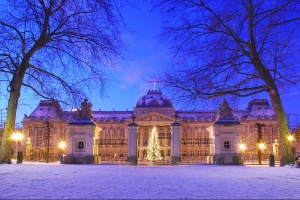Difference between revisions of "United States of Quentin Capitol Building"
Maximumjedi (talk | contribs) |
Maximumjedi (talk | contribs) |
||
| Line 2: | Line 2: | ||
|name=United States of Quentin Capitol | |name=United States of Quentin Capitol | ||
|text_color=white | |text_color=white | ||
| − | |color= | + | |color=blue |
|flag=Capitol_Building_USQ_federal.png | |flag=Capitol_Building_USQ_federal.png | ||
|caption=The main facade of the Capitol Building | |caption=The main facade of the Capitol Building | ||
| Line 40: | Line 40: | ||
== Interior == | == Interior == | ||
| − | === Entrance === | + | === Entrance Hall === |
| − | + | === Green Representatives Chamber === | |
| + | |||
| + | === Bureaucratic Orthotope === | ||
| + | |||
| + | === Clockington Hall === | ||
| + | |||
| + | === Firedawn Catacombs === | ||
Revision as of 18:32, 12 June 2020
| United States of Quentin Capitol | |||||
|---|---|---|---|---|---|
| |||||
| General Information | |||||
| Architectural Style | Neoclassical | ||||
| Address | 6312 Capital Street Mechanicsburg, GA USQ | ||||
| Current Tenants | United States of Quentin Congress House of Representatives House of Bureaucrats | ||||
| Architectural Firm | James Toit | ||||
| Construction Began | May 1st, 1839 | ||||
| Completed | 1842 | ||||
| Floors | 3 | ||||
| Telephone | 777-777-7771 | ||||
| Megasite | capitolbuilding.gov.nwd[1] | ||||
The Capitol Building was originally commissioned in May of 1839, five years after the ratification of the federal Constitution which created the new nation and its government. For the first five years of its existence, Congress was located at the Territorial Assembly House across the Logan River in Mechanicsburg, however the building soon became too small to accommodate both houses of Congress. Construction began that year, headed by James Toit and hundreds of workers from across the country, and was completed in 1842, although not as it is today. Later, in 1865 and 1983, the Capitol was renovated, with gates, the large gardens at the front, interior decoration, and a rear wing being added.
Contents
History
The Capitol Building was originally commissioned in May of 1839, five years after the ratification of the federal Constitution which created the new nation and its government. For the first five years of its existence, Congress was located at the Territorial Assembly House across the Logan River in Mechanicsburg, however the building soon became too small to accommodate both houses of Congress. Construction began that year, headed by James Toit and hundreds of workers from across the country, and was completed in 1842, although not as it is today. Later, in 1865 and 1983, the Capitol was renovated, with gates, the large gardens at the front, interior decoration, and a rear wing being added.
Throughout the centuries, the building was continuously used as the Capitol, and a number of important laws and bills were passed there, along with all the amendments to the nation's Constitution. No opposing force ever was able to occupy the building or Mechanicsburg, and numerous Congresspeople have occupied the nearly 150 offices in the building. Also included in the Capitol is the two chambers, one for the House of Bureaucrats, and one for the Quentinian House of Representatives. The Unity Chamber is where both Houses convene for conjoined meetings. The building is kept up today by the Quentinian Department of Infrastructure, along with the Quentinian Department of Monuments.
Exterior
Grounds
The grounds of the Capitol Building are not large, however outline the building as well as reach out to the back and front more than the building itself does. In the front is a large garden, featuring decorative hedging and paths through the hedging to the capitol. These paths are often walked by officials on break, or by visitors, and benches are included. Past the hedging to the left side of the building is a colonnade which leads to the security entrance area, ensuring officials can enter through the security area and walk directly into the building via the colonnade. The area to the right of the hedging is also similar, however this is used more often by the House of Bureaucrats members, as they work on the right side of the building.
Behind the capitol building is a small area of grounds with trees, where officials can walk and discuss. This area is closed to the public. Finally, Mechanicsburg Capitol Square park is technically included in the grounds of the capitol, however the Verrecchia Building on the other side of the park also has a claim to the park square as its grounds. In reality, the park functions as independent from the two buildings, however.
Flags and Decoration
By tradition, at least three flags are always flown on the capitol building, one in the center, and one for each of the building's wings. In addition, one larger flag has also been draped along the back of the capitol, above the exit from the building to the grounds in the back of the building. Two flags are usually flown on top of the security entrances on each side of the main building, and flags are also set up to commemorate occasions such as inaugurations or large events. Other decoration at the capitol, besides the decorative hedging, includes the gates, which are decorated with gold and sometimes with lights colored for special occasions. On the level of steps close to the building, there are many lampposts, which illuminate the pathways.

